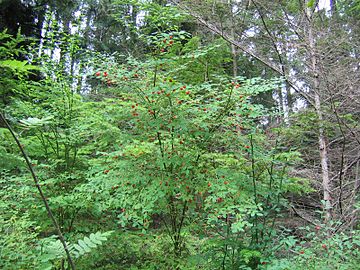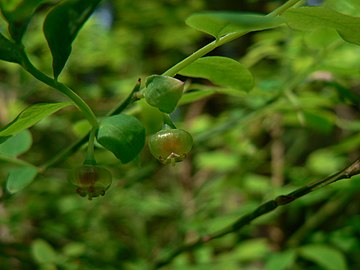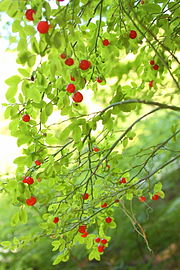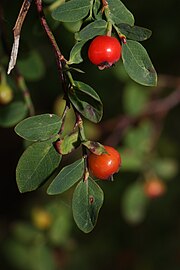Vaccinium parvifolium
| Vaccinium parvifolium | |
|---|---|

| |
| Fruit and leaves in Issaquah, Washington | |
| Scientific classification | |
| Kingdom: | Plantae |
| Clade: | Tracheophytes |
| Clade: | Angiosperms |
| Clade: | Eudicots |
| Clade: | Asterids |
| Order: | Ericales |
| Family: | Ericaceae |
| Genus: | Vaccinium |
| Species: | V. parvifolium
|
| Binomial name | |
| Vaccinium parvifolium | |
Vaccinium parvifolium, the red huckleberry, is a species of Vaccinium native to western North America.
Description
It is a deciduous shrub growing to 4 metres (13 feet) tall with bright green shoots with an angular cross-section. The leaves are ovate to oblong-elliptic, 9 to 30 millimetres (1⁄4 to 1+1⁄4 inches) long, and 4 to 16 mm (1⁄8 to 5⁄8 in) wide, with an entire margin.[1]
The flowers are yellow-white to pinkish-white with pink, decumbent bell-shaped 4 to 5 mm (3⁄16 to 3⁄16 in) long.[1]
The fruit is an edible red to orange berry 6 to 10 mm (1⁄4 to 3⁄8 in) in diameter.[1]
Distribution and habitat
It is common in forests from southeastern
In the Oregon Coast Range, it is the most common Vaccinium.[2] It grows in moist, shaded woodlands.[3]
Ecology
Birds, bears, and small mammals eat the berries. Deer and some livestock forage the foliage.[4]
Cultivation
The species is cultivated in the specialty
As a crop plant (along with the other huckleberries of the genus in western North America), it is not currently grown on a large
Uses
The bark or leaves of the plant were brewed for a bitter
Huckleberries can be eaten fresh or dried or prepared as a tea or
References
- ^ a b c d e f g Holm FG (May 2004). "The Natural History of Vaccinium parvifolium Smith, the Red Huckleberry". The Evergreen State College, Olympia, Washington. Retrieved November 25, 2014.
- ISBN 978-1-55105-530-5.
- ^ "Vaccinium parvifolium". ucjeps.berkeley.edu. Retrieved 2022-09-16.
- ISBN 0-394-73127-1.
- ^ "Vaccinium parvifolium". California Native Plant Link Exchange. Retrieved November 25, 2014.
- ^ "Vaccinium parvifolium". Jepson Horticultural Database. Retrieved November 25, 2014.
- ^ "Information on Huckleberry Plants". Northwest Berry & Grape Information Network. Archived from the original on July 20, 2013. Retrieved November 25, 2014.
- ^ a b "Vaccinium parvifolium". Plants for a Future. Retrieved November 25, 2014.
- OCLC 965922681.
External links
- "Vaccinium parvifolium". Germplasm Resources Information Network. Agricultural Research Service, United States Department of Agriculture.
- Jepson Flora Project: Vaccinium parvifolium
- Native American Ethnobotany: Vaccinium parvifolium
- Plants of British Columbia: Vaccinium parvifolium
- USDA: Vaccinium parvifolium





